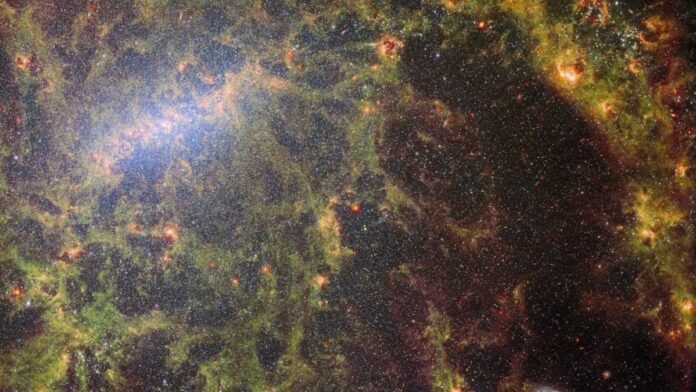The James Webb Space Telescope (JWST) has captured a stunning image of a distant barred spiral galaxy as astronomers aim to study star birth in the deeper regions of space.
JWST observed the galaxy NGC 5068, located 17 million light-years away in the constellation Virgo, as part of its mission to build what the European Space Agency (ESA) calls a “treasure trove” of star formation observations in relatively nearby galaxies.
This repository could help scientists better understand the processes of star formation and, thus, how barred spiral galaxies like our own Milky Way evolve.
Related: James Webb Space Telescope (JWST) — A complete guide
The portrait of NGC 5068 shows tendrils of gas and stars stretching throughout the barred spiral galaxy. The bright and dense central bar of the galaxy, which sets it apart from “non-barred” spiral galaxies, can be seen in the upper left-hand corner of the image.
These large central bars are not solid objects but are instead made of tightly clustered stars, and the stellar bars possessed by galaxies like NGC 5068 may indicate they are older and more evolved than unbarred spiral galaxies. This is because these structures are believed to take around 2 billion years to form.
As this bar of stars swirls, astronomers think it may pull gas and dust to the center of these galaxies, where it acts as the fuel for intense bursts of star formation. The action of the bar in NGC 5068 seems to be causing stars to form in a spiral-like shape. These thick clouds of gas and dust that collapse to create stars also block visible light, making opaque star-forming regions difficult to study, at least in visible light wavelengths of the electromagnetic spectrum.

JWST is the ideal instrument to peer through these clouds because infrared light passes through dust and gas mostly unimpeded, and the powerful space telescope that launched on Christmas Day in 2021 is designed to see the universe in infrared.
This image of NGC 5068, a galaxy that has a diameter of at least 45,000 light-years and is seen face-on from Earth, was created using two of the JWST’s primary instruments Mid-InfraRed Instrument (MIRI) and the Near-Infrared Spectrograph (NIRSpec) both attuned to different wavelengths of infrared light.
Thus far, JWST has collected images of 19 relatively nearby star-birthing galaxies, which astronomers should be able to combine with a wealth of observations from other space-based telescopes and ground-based observatories to better understand star formation. These include Hubble Space Telescope images of over 10,000-star clusters, spectroscopic mapping of around 20,000 clusters, observations of star-forming emission nebulas from the Very Large Telescope (VLT) and imaging of 12,000 dark and dense molecular clouds identified by the Atacama Large Millimeter/submillimeter Array (ALMA).
Combined, these observations give astronomers a picture across a wide spread of the electromagnetic spectrum, potentially exposing in detail the characteristics of star formation.

